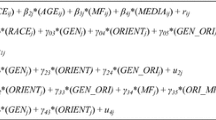Abstract
In an experimental study, male and female university students were asked to indicate how attracted they were to an opposite gender stimulus person after being presented information about the person's physical attractiveness, earning potential, and expressiveness. As hypothesized, subjects were more attracted to a physically attractive person than to a physically unattractive person, more attracted to a person with high earning potential than to a person with low earning potential, and more attracted to a high-expressive person than to a low-expressive person. Of these three characteristics, physical attractiveness had the greatest effect on attraction. Contrary to sex role stereotypes, males and females were similarly affected by these partner characteristics. Gender differences, however, did emerge in the subjects' estimates of the effects of these characteristics on their attraction. Consistent with sex role stereotypes, males placed greater emphasis than females on physical attractiveness, and females placed greater emphasis than males on earning potential and expressiveness. The discrepancy between the experimental results and the subjects' perceptions of how the factors affected their attraction were interpreted to indicate that people may not be aware of what attracts them to another and may use “implicit causal theories” provided by the culture to explain their attraction responses.
Similar content being viewed by others
References
Brehm, S. S. Intimate relationships. New York: Random House, 1985.
Buss, D. M., & Barnes, M. Preferences in human mate selection. Journal of Personality and Social Psychology, 1986, 50, 169–174.
Byrne, D., Ervin, C. E., & Lambert, J. Continuity between the experimental study of attraction and the real-life computer dating. Journal of Personality and Social Psychology, 1970, 16, 157–165.
Cameron, C., Oskamp, S., & Sparks, W. Courtship American style: Newspaper ads. The Family Coordinator, 1977, 26, 27–30.
Coombs, R. H., & Kenkel, W. F. Sex differences in dating aspirations and satisfaction with computer-selected partners. Journal of Marriage, 1966, 28, 62–66.
Curran, J. P., & LKippold, S. The effects of physical attractiveness and attitude similarity on attraction in dating dyads. Journal of Personality, 1975, 43, 528–539.
Deaux, K., & Hanna, R. Courtship in the personal column: The influence of gender and sexual orientation. Sex Roles, 1984, 1, 363–375.
Duck, S., & Sants, H. On the origin of the specious: Are personal relationship really interpersonal states? Journal of Social and Clinical Psychology, 1983, 1, 27–41.
Friedman, H. W., Riggio, R. E., & Casella, D. F. Nonverbal skill, personal charisma, and initial attraction. Personality and Social Psychology Bulletin, 1988, 14, 203–211.
Green, S. K., Buchanan, D. R., & Heuer, S. K. Winners, losers, and choosers: A field investigation of dating initiation. Personality and Social Psychology Bulletin, 1984, 10, 502–511.
Harrison, A. A., & Saeed, L. Let's make a deal: An analysis of revelations and stipulations in lonely hearts advertisements. Journal of Personality and Social Psychology, 1977, 35, 257–264.
Hatfield, E., & Sprecher, S. Mirror mirror.... The importance of looks in everyday life. New York: State University of New York Press, 1986.
Hill, R. Campus values in mate selection. Journal of Home Economics, 1945, p. 37.
Howard, J. A., Blumstein, P., & Schwartz, P. Social or evolutionary theories? Some observations on preferences in human mate selection. Journal of Personality and Social Psychology, 1987, 53, 194–200.
Hoyt, L. L., & Hudson, J. W. Personal characteristics important in mate preference among college students. Social Behavior and Personality, 1981, 9, 93–96.
Hudson, J. W., & Henze, L. F. Campus values in mate selection: A replication. Journal of Marriage and the Family, 1969, 31, 772–775.
Koestner, R., & Wheeler, L. Self-presentation in personal advertisements: The influence of implicit notions of attraction and role expectations. Journal of Social and Personal Relationships, 1988, 5, 149–160.
Laner, M. R. Parmanent partner priorities: Gay and straight. Journal of Social and Personal Relationships, 1977, 2, 377–383.
Lynn, M., & Bolig, R. Personal advertisements: Sources of data about relationships. Journal of Social and Personal Relationships, 1985, 2, 377–383.
McGinnis, R. Campus values in mate selection: A repeat study. Social Forces, 1959, 36, 368–373.
Meredith, M. The influence of physical attractiveness, independence, and honesty on date selection. Unpublished manuscript, Department of Psychology, Western Illinois University, 1972.
Murstein, B. I. Who will marry whom? Theories and research in marital choice. New York: Springer, 1976.
Nevid, J. S. Sex differences in factors of romantic attraction. Sex Roles, 1984, 11, 401–411.
Nisbett, R. E., & Wilson, T. D. Telling more than we can know: Verbal reports on mental processes. Psychological Review, 1977, 84, 231–259.
Riggio, R. E., & Woll, S. B. The role of nonverbal cues and physical attractiveness in dating choice. Journal of Social and Personal Relationships, 1984, 1, 347–357.
Snyder, M. Berscheid, E., & Glick, P. Focusing on the exterior and the interior: Two investigations on the initiation of personal relationships. Journal of Personality and Social Psychology, 1985, 48, 1427–1439.
Stretch, R. H., & Figley, C. R. Beauty and the best: Predictions of interpersonal attraction in a dating experiment. Psychology: A Quarterly Journal of Human Behavior, 1980, 17, 35–43.
Walster, E., Aronson, D., Abrams, D., & Rottmann, L. Importance of physical attractiveness in dating behavior. Journal of Personality and Social Psychology, 1966, 4, 508–516.
Woll, S. So many to choose from: Decision strategies in videotaping. Journal of Social and Personal Relationships, 1986, 3, 43–52.
Author information
Authors and Affiliations
Additional information
An earlier draft of this paper was presented at the Second Iowa/International Network Conference on Personal Relationships, Iowa City, May 1989. The author would like to thank all of the following people for reading an earlier draft of the paper: Elaine Hatfield, Kathleen McKinney, Sandra Metts, Glenn Reeder, and Eric Rice.
Rights and permissions
About this article
Cite this article
Sprecher, S. The importance to males and females of physical attractiveness, earning potential, and expressiveness in initial attraction. Sex Roles 21, 591–607 (1989). https://doi.org/10.1007/BF00289173
Issue Date:
DOI: https://doi.org/10.1007/BF00289173




